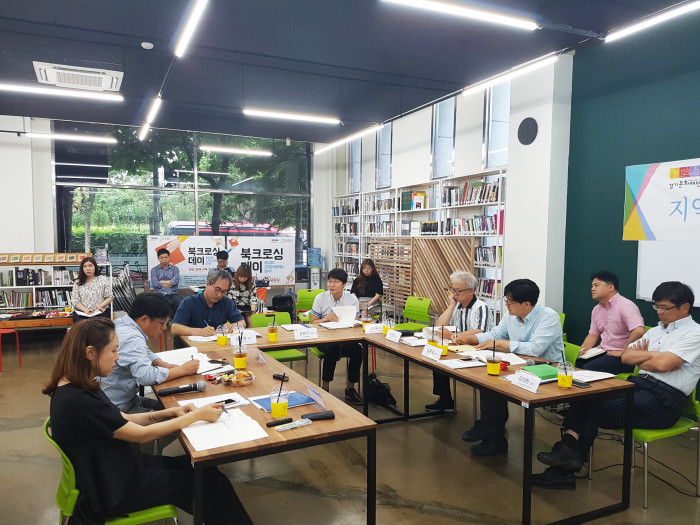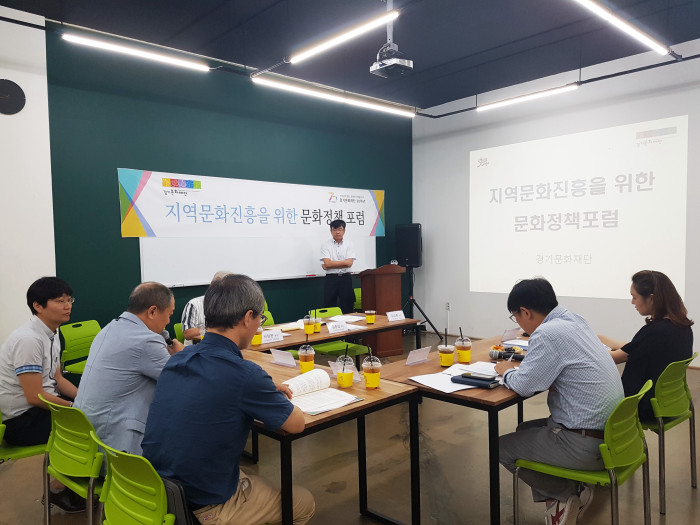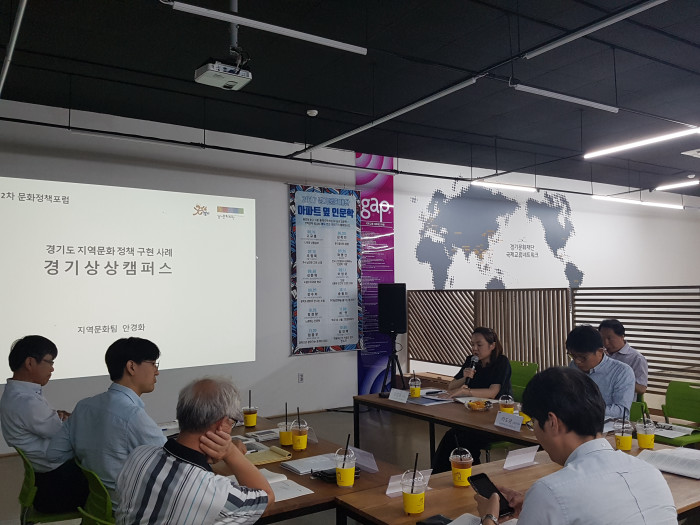경기문화재단
How to Interpret and Assess Life with Culture
The 2nd Cultural Policy Forum
Cultural Policy is a quarterly magazine published by the Gyeonggi Cultural Foundation since the summer of 2017 with the purposes of identifying new trends in cultural policies at home and abroad, gathering the opinions of experts in relevant areas, and introducing the directions and contents of diverse cultural policies promoted by Gyeonggi Provincial Government and Gyeonggi Cultural Foundation. |

President Sul We need to deliberate on cultural policies that are feasible and that reflect each local area’s uniqueness. We also need to form a conceptual and philosophical basis for this.
Kim Jong-gil It would be desirable to start our discussion by reflecting on what it is to have a “planner’s attitude.”
Kim Changyoung Those working on cultural policy need to have a understanding of how to fill in the survey form. First of all, there is obviously a limit to the traditional criteria of survey. Monitoring activities aren’t generating visible effects because of the wrong measurement criteria. In particular, it is never easy to assess culture so it is all the more important to seriously reflect on if we have set the right direction for measurement (e.g. target and scope). Moreover, when coming up with a questionnaire, we need to make efforts to remove any element that could form prejudice in survey participants.
Kim Jong-gil We call it “survey” but it is actually more about asking specific questions about the detailed lifestyle of those living in a certain area. I would thus like to ask you to elaborate on the role of a “cultural mediator,” the meaning of such a role and a planner’s attitude.
Cho Jung-yun Changing culture consists in generating not a trickle-down effect but a trickle- up effect. That is because individual movements gather together in order to finally change the big framework. Korea’s metropolitan cultural foundations now need to refrain from directly conducting projects. What is then the role of a cultural foundation? Clarifying this role requires us to clarify the position of local citizens. Korea’s definition of “middle-income family” is based on economic criteria but other countries also use cultural criteria. Korea should thus adopt a new concept of “cultural middle-income family” to approach this issue.
Kim Jong-gil When it comes to Korea’s policy transition to “cultural democracy,” it is necessary to understand the policy’s inflection point. In this context, I would like to ask a question to Mr. Seo Jeong Moon who has witnessed all of the country’s policy inflection points as a first-generation cultural planner of GyeongGi Cultural Foundation. Since the integration of provincial museums in 2008, local cultural planners’ career opportunities seem to have diminished, leading to unfavorable conditions for cultural invigoration. Do you agree?
Seo Jeong Moon The Foundation was established to operate and manage the central government’s policy on arts and culture in an organized manner. For about ten years after its establishment, the Foundation focused on projects supporting public contests. Afterward, as the country’s cultural policy changed, the Foundation also came to carry out projects supporting professionals and amateurs. In this process, there was also some disagreement over support for amateurs. As the projects supporting amateurs met the Foundation’s employees with a planner’s attitude, a term called “everyday culture” appeared. In the meantime, the scope of the country’s law also widened to support civic groups.
As the focus shifted from the arts to culture, the Foundation began to support projects not for professionals but for a wide range of civic groups and residents (including new residents like migrants, adolescents, young people and persons with disabilities), providing minimum guidelines. As the Foundation put more emphasis on supporting local events led by local residents, it gradually changed from a planner to a manager. It has been six months since I took charge of the Local Intermedia Team. Now, I feel the need to create exemplary cases regarding the Foundation’s onsite activities. As for the platform of everyday culture, experts need to think from local residents’ perspective to discover local human resources and to build capacity. After that, even if the existing staff stops supporting a certain project sometime in the future, the local staff will be ready to continue the work.
I believe that according to the current trend, culture belongs to social topography. That is why cultural, artistic and individual contributions are necessary to lead to a mature society. We also need to discover those who don’t benefit from policy and make efforts to support them so that they can better make use of their individuality. Furthermore, metropolitan cultural foundations need to serve as a mediator that provides them with opportunities to grow and change the existing system like pioneers. So we now need to reflect on how to make the current situation more favorable for growth.

Kim Jong-gil Before wrapping up our discussion, I would like to listen to your opinions on how big projects regarding space and site regeneration influence local areas and how these projects should be connected to local cultural invigoration.
Cho Jung-yun It is true that Korea tends to imitate Western urban regeneration of the 2000’s. I want the country to discover and share its own cases. To prevent confusion, I would also like to clarify a term. Busan Cultural Foundation came up with the term “youth culture” to mean young people’s culture but the English term itself is closer to adolescents’ culture. In other words, this led to policy decoupling. In short, we need to try to prevent such decoupling and make sure that every policy has a clear goal.
Kim Jong-gil What role should metropolitan cultural foundations play for local cultural invigoration?
Kim Changyoung Metropolitan cultural foundations’ main job is to measure the results of their current projects. So their priority is to have positive results which inevitably depend on indices. We thus need to develop clear grounds and indices that would allow us to measure such results without ranking different foundations. The role of metropolitan governments is to resolve such issues of measurement and to set a desirable future direction for metropolitan cultural foundations.
Kim Jong-gil Please share your concerns about local culture, focusing on what you felt on Sangsang Campus.
Ahn Kyunghwa We still don’t have any clear definition of “local culture.” We need to clarify it before setting our goal. It is also difficult to explain what GyeongGi-do Province’s identity is. GyeongGi Cultural Foundation thus needs to start by reflecting more on what local culture is and what GyeongGi-do Province is.
Kim Jong-gil The Local Intermedia Team belongs to the Arts and Culture Headquarters of GyeongGi Cultural Foundation. Frankly speaking, the team isn’t compatible with the headquarters.

Ahn Kyunghwa Local culture is inevitably connected to the central government. However, it is connected to it mostly on the basis of land research and real estate. Culture seems to be added to them in just a small quantity. So I’m concerned that such government projects are just making conditions favorable for the reconstruction of apartment buildings.
Kim Jong-gil If Korea’s Local Culture Promotion Act is implemented successfully, the act is expected to have great ripple effects. The same is true for the adoption of the cultural impact assessment system. So those working on local culture should share their philosophy of local cultural policy.
Lee Jee-hun In order to discuss local culture, we first need to separate “local areas” and “culture” and reflect on “local areas.” In the same city, differences exist according to different areas and social statuses. GyeongGi-do Province particularly has a wide gap regarding these elements. For example, if someone says, “I live in Bundang.” or “I live in Icheon.” it also implies their financial status to some point. In other words, economic factors are at the center of forming identity. For the past twenty years, GyeongGi Cultural Foundation has actively focused on “culture” but the Foundation will have to shift its focus to “local areas.” in the future.
Seo Jeong Moon Culture should be divided into spheres of life. We need to study the term “local areas” and to be able to create projects ourselves.
Kim Jong-gil Instead of regarding GyeongGi as just a province, we need to tell its people’s stories. Under these circumstances, we need a clear definition of “GyeongGi” That’s it for today’s forum. Thank you.
Cultural Policy Bulletin Vol.2 E-book
<ggc의 모든 콘텐츠는 저작권법의 보호를 받습니다.>
세부정보
Facilitator/ Kim Jong-gil, Chief Curator of Cultual Innovation Team
Participants
/ Seo Jeong Moon, Director of Local Intermedia Team
/ Ahn Kyunghwa, Chief Curator of Local Intermedia Team
/ Lee Jee-hun, Center Manager of The Center for GyeongGi Studies
/ Cho Jung-yun, Manager of Planning & Public Relations Team at Busan Cultural Foundation
/ Kim Changyoung, Director of World Research